Abstract
Introduction: Estimating aboveground biomass (AGB) in protected forests is a challenge, due to high costs and legal restrictions for direct assessments, and also to frequently weak estimation provided by general AGB equations. Objective: We propose a new approach that uses dead fallen trees (DFTs) to improve AGB estimation. We aim to analyse if the adjustment of allometric models based on DFTs provides a suitable local equation for AGB estimation or helps to validate existing pantropical or regional allometric equations. Methods: The study was carried out at the Dois Irmãos State Park (PEDI), Pernambuco, Northeast Brazil. Along 4 000 m, using the line intersect technique, we sampled 37 recent dead fallen trees ranging from 7.6 to 92.3 cm in diameter and from 8.6 to 29.4 m in height. Nine models were adjusted, and the best equation (local) was compared to regional and pantropical equations. Results: One equation (AGBkg= 1.5292* DBH2.0601*TH-0.2187) produced biomass estimates which did not differ from the observed values (P > 0.05). Differently from the others, this equation overestimated AGB in only 2.8 % and, along with other parameters of analysis (R2adj and Syx %) had the best overall performance. Analysing the performance of the local equation versus available equations for estimating AGB, we found that only the local and the pantropical equations by Pearson et al. (2005) estimated values that were not significantly different from observed values. However, the local equation is more appropriate for local estimation of AGB, since it has the lowest RSME and CV. Conclusions: Based on the proposed approach, we were able to offer a local equation for tree AGB estimation based on fallen trees. The DFT method is efficient regarding time and costs, avoiding tree logging in protected forests and helps to guide the choice of a proper equation for forest AGB demands.
##plugins.facebook.comentarios##

This work is licensed under a Creative Commons Attribution 4.0 International License.
Copyright (c) 2020 NATHAN CASTRO FONSÊCA



